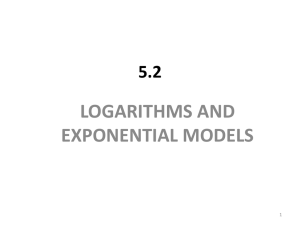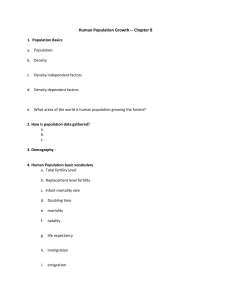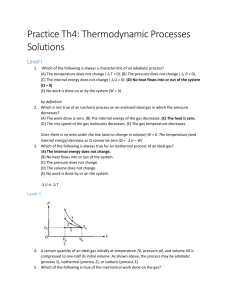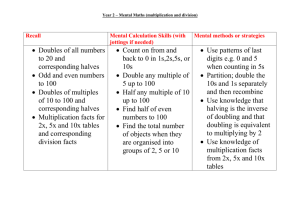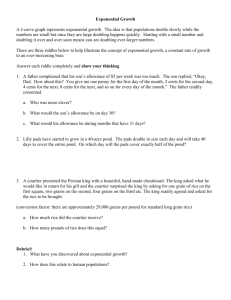Bacterial Growth: Exponential Equations & Generation Time
advertisement
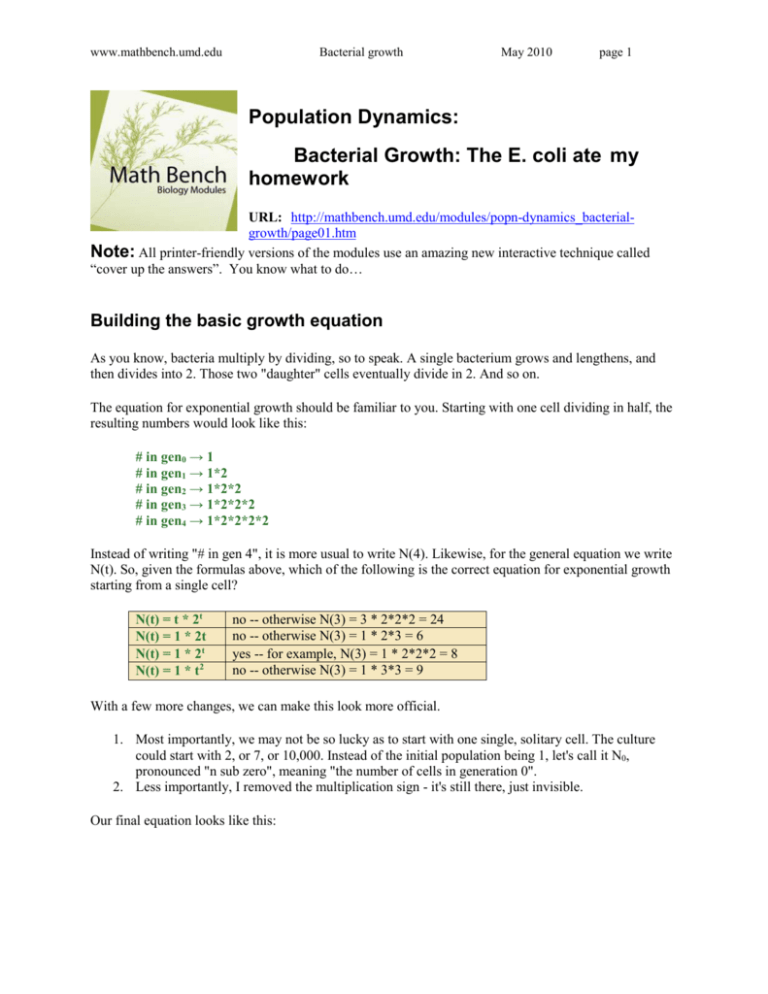
www.mathbench.umd.edu Bacterial growth May 2010 page 1 Population Dynamics: Bacterial Growth: The E. coli ate my homework URL: http://mathbench.umd.edu/modules/popn-dynamics_bacterialgrowth/page01.htm Note: All printer-friendly versions of the modules use an amazing new interactive technique called “cover up the answers”. You know what to do… Building the basic growth equation As you know, bacteria multiply by dividing, so to speak. A single bacterium grows and lengthens, and then divides into 2. Those two "daughter" cells eventually divide in 2. And so on. The equation for exponential growth should be familiar to you. Starting with one cell dividing in half, the resulting numbers would look like this: # in gen0 → 1 # in gen1 → 1*2 # in gen2 → 1*2*2 # in gen3 → 1*2*2*2 # in gen4 → 1*2*2*2*2 Instead of writing "# in gen 4", it is more usual to write N(4). Likewise, for the general equation we write N(t). So, given the formulas above, which of the following is the correct equation for exponential growth starting from a single cell? N(t) = t * 2t N(t) = 1 * 2t N(t) = 1 * 2t N(t) = 1 * t2 no -- otherwise N(3) = 3 * 2*2*2 = 24 no -- otherwise N(3) = 1 * 2*3 = 6 yes -- for example, N(3) = 1 * 2*2*2 = 8 no -- otherwise N(3) = 1 * 3*3 = 9 With a few more changes, we can make this look more official. 1. Most importantly, we may not be so lucky as to start with one single, solitary cell. The culture could start with 2, or 7, or 10,000. Instead of the initial population being 1, let's call it N0, pronounced "n sub zero", meaning "the number of cells in generation 0". 2. Less importantly, I removed the multiplication sign - it's still there, just invisible. Our final equation looks like this: www.mathbench.umd.edu Bacterial growth May 2010 page 2 What does exponential growth look like? Hopefully at this point in your career as a biology student, you have seen a graph of exponential growth. The online version of this module contains an interactive applet which allows you to draw and compare exponential curves. To find this applet got to: http://www.mathbench.umd.edu/modules/popndynamics_bacterial-growth/page02.htm If you take the log of an exponential growth curve, the graph "unbends" itself and turns into a straight line. This kind of graph is called "log-transformed." What happens is a series of numbers that are evenly spaced on a linear scale get spaced differently on a log scale: specifically, on a log scale, the largest numbers get squished together, while the smallest numbers get stretched apart. The online version of this module contains an interactive applet which allows you to log transform the graph of exponential growth and then transform it “back” to a normal graph. To find this applet go to: http://www.mathbench.umd.edu/modules/popndynamics_bacterial-growth/page02.htm Why does log-transformation unbend the plot of exponential growth? Log transformation is a very powerful tool in biology, even if it cannot transform 18-wheelers or pickups trucks into sentient beings. What you do when you log-transform data is change the scale of the data. Normal everyday data is usually expressed on a graph with a linear scale. Linear means that each tickmark on the axis increases the number by the same amount -- for example, the tickmarks might stand for 0, 5, 10, 15, etc. However, our bacterial population is not increasing by the same amount in each timestep. Starting with 1 cell, in the first timestep we add 1 more, in the second timestep we add 2 more, in the third timestep we add 4 more, and so on. The graph does not look like a straight line. When you transform data, you are putting it on a log scale, which is also called a multiplicative scale. The tickmarks on a multiplicative scale represent numbers that differ by the same FACTOR, or www.mathbench.umd.edu Bacterial growth May 2010 page 3 multiplier. And in fact our bacterial populations also differ by the same factor at each timestep -- they double, or increase by a factor of 2. So when you use a log scale, populations separated by the same factor will line up in a straight line. The slope of that line will depend on how big the multiplying factor is, which we'll talk about in a few screens. But the crucial point is: ANY population that grows or shrinks by a constant factor will appear as a straight line when logtransformed. Do ALL curves get "unbent" by taking the log? The only curves that get straightened after log transformation are the ones generated by functions that include "some number to the power of the x variable". Why is that? Recall: ANY population that grows or shrinks by a constant factor will appear as a straight line when logtransformed. All of the other functions involve some sort of change in which the factor of change is NOT constant. Let's take the parabola, for example: y = x2 1 x 1 y factor 2 4 4 3 9 2.25 4 16 1.78 5 25 1.56 6 36 1.44 The factor by which y is increasing starts at 4, then drops to 2.25, then 1.78, and so on. Although we might think that a parabola grows "pretty fast", it is in fact "slow" compared to exponential growth that starts with the same factor. As a general guideline: if growth factors are increasing, then growth is proceeding faster than exponential, and that part of the log-transformed curve will have a relatively steep slope. if growth factors are decreasing, then growth is proceeding slower than exponential, and that part of the log-transformed curve will have a relatively gentle slope. Only constant growth factors (exponential growth) leads to a straight-line when the graph is log-transformed. But how long is a generation? Imagine a single bacterial cell. You might think a cell that is not actively dividing is sitting around, twiddling its non-opposable thumbs or knitting or something. However, this is not actually true. For a while (anywhere from 20 minutes to a few days) the cell spends its time gathering nutrients and synthesizing extra cellular structures. Once that is done, it can divide into two. Any given strain of bacteria requires, on average, a certain amount of time to gather nutrients and organize itself to divide (of course the time required depends a lot on the amount of nutrients available, the temperature, and so on). Nevertheless, if you know what the environment is like, you can make some educated guess about how long it will take a bacterial cell to divide. www.mathbench.umd.edu Bacterial growth May 2010 page 4 So this is our first and most straightforward way of measuring growth rate: g = generation time = average time for cell to divide The online version of this module contains an interactive applet which allows you to match bacteria with their doubling time under ideal conditions. To find this applet go to: http://www.mathbench.umd.edu/modules/popndynamics_bacterial-growth/page05.htm Finding generation time on a graph Finding generation time should be pretty intuitive. Basically, you look for the amount of time it took the population to double. On the graph below, use the data trace box to find the point at which the population size has doubled: The online version of this module contains an interactive applet which allows you to find the doubling (generation) time of a population growing exponentially. To find this applet go to: http://www.mathbench.umd.edu/modules/popndynamics_bacterial-growth/page06.htm By definition, if a population is in exponential growth, it always takes the same amount of time to double. So, it doesn't matter where you start, as long as the population doubles, you'll have found the generation time. The online version of this module contains an interactive applet which allows you to find the doubling (generation) time of a population growing non-exponentially. To find this applet go to: http://www.mathbench.umd.edu/modules/popndynamics_bacterial-growth/page06.htm Is this growth exponential? The first useful application of the idea of doubling time is that it allows you to determine whether a population is indeed in exponential growth. So, a general procedure for deciding whether growth is exponential is to determine whether the population size continues to double in the same amount of time. If doubling time gets longer, then growth is slowing down. If it gets faster, growth is speeding up. www.mathbench.umd.edu Time 10:10 am 10:34 am 10:38 am 10:46 am 11:00 am 11:06 am # E. Coli 2.4 x 105 4.3 x 105 4.8 x 105 5.9 x 105 8.2 x 105 9.6 x 105 Bacterial growth May 2010 page 5 Is this population growing exponentially? How do you know? Find the doubling time of this population of E. coli Check if the doubling time is same everytime Answer: The population doubles between 10:10 and 10:38. It doubles again between 10:38 and 11:06. In both cases, the doubling took the same amount of time (28 minutes) so YES, the population is growing exponentially. In search of ... the exact doubling time So far, we've been guesstimating doubling time from a graph of population over time, or we've calculated it directly from a table. But there are a few problems... First, guesstimating a parameter from a graph is not really approved scientific procedure. It would be hard to imagine publishing a report in the Journal of the American Medical Association that started out "we looked at the graph, squinted a little, and decided that the doubing time was 23 minutes...". Secondly, when we calculated the doubling time from the table, that only worked because the table happened to include an exactly doubled population. If the table does NOT contain a doubled population entry, then you're in trouble. In other words, we can figure out the exact doubling time for this E. nice below, but not for E. naughty: time 10:00 10:20 E. nice 10 million 20 million E. naughty 10 million 15 million At first glance, it appears that the population got "halfway" to doubling, so doubling time should be 40 minutes. Let's see if that's true -- if the population keeps growing at the same rate, will it double in 40 minutes? time 10:00 10:20 10:40 E. messy 10 million ... multiply by 1.5 to get 15 million ... multiply by 1.5 to get 22.5 million www.mathbench.umd.edu Bacterial growth May 2010 page 6 Oops, we got to 22.5, not 20 million. Granted, this is a small difference, but it's still not the right answer. Like the old joke goes, a million here, a million there, pretty soon you're talking about a real epidemic. What we need is a foolproof way to determine exactly what the doubling time is. Finding doubling time with messy numbers Recall that we started out with an equation: Nt = N0*2g Let's say I told you that N0 was 10 million and Nt was 80 million one hour later. You would probably think to yourself, "well, the population doubled three times, from 10 to 20 million, from 20 to 40 million, and from 40 to 80 million. Since three doublings took 1 hour, that means each doubling took 20 minutes." Another somewhat fancier way of getting the same answer would be to substitute the information that you know (Nt and N0) into the equation above, and solve for the information that you don't know (number of generations, g). Here's how that would look: Nt = N0 *2g 80 million = 10 million * 2g 8 = 2g g must be 3 60 minutes / 3 = 20 minutes sub in the known information divide both sides by 10 million use what you know about exponents you know they happened in 1 hour so generation time is 20 minutes. We will need to do same basic procedure with messier numbers. Let's say the population increased from 10 to 90 million in one hour. Nt = N0*2g 90 million = 10 million * 2g 9 = 2g g must be ... sub in the known information divide both sides by 10 million try to use what you know about exponents uh oh Here's a hint: when you have a problem with exponents, try logs. The online version of this module contains an interactive applet which allows to practice with an exponent problem. To find this applet go to: http://www.mathbench.umd.edu/modules/popndynamics_bacterial-growth/page09.htm www.mathbench.umd.edu Bacterial growth May 2010 page 7 Doubling time practice for fun and profit A strep culture is sampled at two points in time, 1 hour and 10 minutes apart. 3.2 x 106 cells/ml are found in the first sample, and 1.8 x 107 cells/ml in the second sample. What was the doubling time? try estimating the doubling time first -- notice that there were between 2 and 3 generations in 70 minutes... when you plug the numbers into the formula, you get 1.8 x 107 = 3.2 x 106 * 2g. dividing both sides by 3.2 x 106 will make the equation less complicated starting with 5.625 = 2g, get g out of the exponent by taking the log of both sides log(5.625) = g log(2), so what's g? g (the number of generations) was 2.49, which took 70 minutes, so what's the generation time? Answer: 70/2.49 = 28.1 minutes. A beginning yogurt maker decides to test how consistently his yogurt cultures grow. He starts with 1 x 105 cells/ml in each of two cultures. After 4 hours, he has 16 x 105 cells/ml in the first culture, and 20 x 105 cells/ml in the second culture. Are the doubling times within 10 minutes of each other? Doubling time for the first culture is easy to figure out even without logs. make sure you state both times in minutes, not hours Since the second culture has more cells/ml, its doubling time must be lower. Answer: Yes, the times are 60 and 55.5 minutes. A syphilis patient has tissue cultures taken one week apart. The first sample has 5000 CFUs per ???, while the second sample has 32000 CFUs. Four days later a third sample has 58000 CFUs. Is the population growing exponentially? what is the doubling time in the first week? what is the doubling time in the next 4 days? remember that exponential growth means constant doubling time Answer: No -- Doubling time was faster for the first week (2.61 days) compared to the next four days (4.66 days). www.mathbench.umd.edu Bacterial growth May 2010 page 8 A doctor receives a pathogen sample which she believes to be M. tuberculosis (doubling time 13 hours in culture). She cultures the sample, finding that it grows from 0.2x105 cells/ml to 8 x 106 cells/ ml in 24 hours. Assuming that the culture was growing exponentially, is the sample likely to be M. tuberculosis? In 24 hours, the cell culture should almost quadruple be careful with that scientific notation! what was the doubling time? Answer: No -- the culture grew 400-fold in 24 hours-- a doubling time of a little under 3 hours. In Search of ... a more convenient equation So now you know how to look at the data on a culture and find the doubling time. What about starting with the doubling time and predicting how the culture should grow? For example, if you know that the doubling time is 22 minutes and the culture grows for 66 minutes, its pretty obvious that it doubles 3 times. For example, if you started with an N0 of 2 million cells/ml, you would end with (approximately) 16 million cells/ml. But can you predict the population size after 55 minutes? Well, yes, you could write: Nt = N0 * 2g, so Nt = 2 million * 2(2.5 generations) [since 55 minutes = 22*2.5, or 2.5 doubling times] If we then want to compare that to something that doubles in 25 minutes, we would write Nt = 2 million * 2(2.2 generations) [since 55 = 25*2.2] What would be really nice would be to have population size as a function of minutes, rather than as a function of the number of generations that have gone by. Then we could simply write Nt = (some function)55 for each population. But how to do this? And while we're at it, mathematicians generally prefer to state growth equations with a base of "e", rather than a base of 2. Why? What's so special about e? First of all, e is just a number -- actually it's a bit less than 3, a decimal that goes on forever without repeating. But its a pretty special number -- you know it has to be, seeing as it has a name. You probably know another named number, pi, which is very useful for calculating quantities related to circles, such as their circumference or area. Like e, pi is simply a number (in this case a bit more than 3), but its so useful that mathematicians gave it a name. Pi is useful for circles, whereas e is useful for exponential equations. The reason is that when you graph the function www.mathbench.umd.edu Bacterial growth May 2010 page 9 y = ex, You get a curve in which the y value and the slope are always equal. The online version of this module contains an interactive applet that allows you to play with the graph of y=ex and see how x, y and slope are related. To find this applet go to: http://www.mathbench.umd.edu/modules/popndynamics_bacterial-growth/page11.htm This is great if you're a mathematician, because it makes the curve growth easier to analyze. Of course, just like very few circles have a diameter of exactly 1, very few populations follow the ex curve exactly. However, with a few modifications, we can make this equation fit our needs. Down and dirty with e-to-the-t Here is the equation we have so far: Nt = N0 * 2ts what we need to do is get rid of the "ts" and put in a t. We've already been using the relationship : # timesteps = actual time / generation length So, for E nice, if the actual time is 50 minutes and the generation length is 20 minutes, then # timesteps = 50/20 = 2.5 Likewise for E. quick: #timesteps = 50/15 = 3.33 We can get rid of "ts" in the above equation by substituting actual time / generation length, or in other words t/g Now our equation looks like this: Nt = N0 * 2t/g This change looks very small, but it's actually quite important. It is simpler to find population size as a function of t, and much more importantly, now we can compare the population sizes by graphing them against actual time. www.mathbench.umd.edu Bacterial growth May 2010 page 10 Comparing apples and oranges Our story so far: Nt = N0 * 2t/g But we can take this even one step farther. Why is the number "2" in this equation? Only because bacteria multiply by doubling. Not all organisms do that, and "2" as a base doesn't necessarily make sense for them. In fact, mathematicians like to use a different base: "e". What is e? It is just a number -- a bit less than 3. But its a pretty special number -- you know it has to be, seeing as it has a name. Remember how we said that with exponential growth: the population always grows by the same factor -for example, a population might grow by 5% in one minute. But how many actual bacteria are added depends on how big the population already is: a population of 100 bacteria grows by 5, whereas a population of 100 million grows by 5 million. That is, the actual growth depends on how big the population already is. But there is one function where the actual growth doesn't just DEPEND ON the size of the population, it is the SAME AS the size of the population. That function is y = ex. So for a mathematician, e is a perfect number for talking about growth, just like pi is a perfect number for talking about circles. And growth equations are often expressed as Nt = N0 * emt where e is some growth constant. If you compare the equation just above with the one at the top of the screen, you see that they are very similar. All (!) we need to do is to figure out how 21/g = em This looks kind of daunting at first, but remember that g is whatever the generation time is. And, since we need to get the "m" out of the exponent, we need to use logs (remember: when you have trouble with exponents, use a log). In this case, since the base is "e", we should use ln (natural log) instead of log base 10. So let's find the value of m for E. nice, which has a generation time of 20 minutes: 21/20 = em ln (21/20) = ln (em) 1/20 * ln (2) = m * ln (e) m = ln (2) / 20 = 0.035 By analogy, for any value of g we would have gotten: m = ln (2) / g www.mathbench.umd.edu Bacterial growth May 2010 page 11 So here is the really truly last version of this equation: Nt = N0 * e 0.035 t, which means the same as Nt = N0 * 2 t/20, which means the same as Nt = N0 * 2 ts, where ts = 20 minutes One more quick calculation for E. fasterus: m = ln (2) / 15 = 0.046 Fun with Rhizobia By now you know how to find the doubling time from a variety of different situations, and how to convert doubling time into a "growth rate" to use with the exponential growth equation, so you can compare 2 or more populations. So let's try some practice problems. You order two bacterial strains from Amazon: L. acidophilous to make yogurt, and R. japonicum to help your vegetable garden. According to the website, L acidophilous has a doubling time of 66 minutes, while R. japonicum has a doubling time of 344 minutes. But when you receive the package, you find that only one strain has been included, and its label was mangled so that it only reads "Nt = N0 * e(0.002 t)". Should you put this one in the yogurt, or dig it into your garden? what is the growth rate, m? you need to solve the equation m = ln(2)/doubling time to find out what the doubling time is. Answer: in the garden. After putting the Rhizobium in your garden, you don't notice much difference for several days. After a few irate phone calls, you discover that you applied the Rhizobium at 1/100 of the necessary strength. Given the growth rate of Rhizobium above, how long will it take for Rhizobium to get up to a useful level Try an estimate first: how many doubling times? between 6 and 7. So, 6.5 * 344 minutes = 2236 minutes, or 37 hours Now try an exact answer : Increasing 100 fold is the same as setting N0 to 1 and Nt to 100. Plug and chug... : 100 = 1 * e(0.002t) take the ln of both sides : ln 100 = 0.002 t Answer: t = 2302 minutes, or 38.4 hours. www.mathbench.umd.edu Bacterial growth May 2010 page 12 But wait, the conditions in your garden are hardly optimal. In fact, the doubling time for R. japonicum is about 10 times longer than in the lab. How does this affect the time you need in your garden? And what is the new growth rate m? You still need the same number of doublings to get to a 100-fold increase But each doubling takes 10 times as long So you need 10 times as much time, that is, 384 hours, or 16 days. Use m = ln(2)/doubling time if doubling time got 10 times bigger, m must have gotten 10 times smaller Answer: time needed = 384 hours, m = 0.0002. So after 8 hours in the garden vs. 8 hours on the labbench, starting with 2.5 million Rhizo each, how many Rhizo do you expect? Nt = 2.5 million * e (0.002*8*60) Nt = 2.5 million * e (0.0002*8*60) Answer: 2.7x106 in the garden, 6.5x106 on the labbench. Note that you did NOT get 10 times more Rhizo with a 10-times increase in growth rate. You need to be careful with exponential growth problems -- always use the equation to double-check your intuition. time day 0 day 7 day 14 number cells (x106) 1.2 4.0 13.5 Find the doubling time first m = ln(2) / doubling time You decide to measure the growth rate in your garden. You culture the Rhizo at three different times, with the following results: What is the actual rate of growth (m) in your garden? Answer: m=0.17 Extended problem #1: E. coli ate my lab report You and your TAs both get lectured about keeping your samples uncontaminated. Why? Is it because you are likely to grow E. coli so monstruous that they threaten to devour your lab bench and escape to nearby spinach fields? Actually, believe it or not, that's not the real problem. The real problem is much more mundane. You've heard the expression "finding a needle in a haystack?" Well, the E. coli that you might contaminate your petri dish with are the proverbial haystack. Let's say you are trying to culture a bacterium that doubles every 2 hours. But unwittingly, you have introduced a tiny amount of E. coli into your culture. Just 1%. How much difference could it make???! www.mathbench.umd.edu Bacterial growth May 2010 page 13 To make things easy, assume that E. coli doubles every 20 minutes. How do matters stand when you come back 8 hours later? What's your needle-to-haystack ratio? The needle: start with 99 target bacteria and double every 2 hours -- how many do you end up with? The haystack : Start with 1 E coli and double evey 20 minutes -- how many do you end up with? The ratio : Now take the ratio... Answer: 17 million / 1600 = approx 1 in 10,000 Wow. (Insert stronger language here). Good luck finding that needle. Here's the same problem with a twist -- messy numbers! We'll go back to making yogurt. Recall that a typical yogurt culture has a doubling time of about 55 minutes. Sadly, the spinach in your quiche lorraine yogurt was contaminated at 0.1% with a virulent strain of E. coli, doubling every 23 minutes. After 24 hours of incubation, what do you find? Simplify those messy numbers: by finding the growth rates per minute. Find the initial conditions: 1 out of 1000 was E. coli, so that means 999 were yogurt culture. The needle : Now grow your yogurt for 24*60 minutes. The haystack : And the E coli... The ratio: 7*1018 / 8 * 1010 = approx 108 Answer: about 100 million to 1 E coli The online version of this module contains an interactive applet that demonstrates exponential growth. To find this applet go to: http://www.mathbench.umd.edu/modules/popndynamics_bacterial-growth/page15.htm Extended problem #2: Exponential growth ends (with a whimper) Enough with the cute little stories. The last few pages are all biology, all the time. I put some of the basic exponential growth information in the box to the right, and the rest is for you to figure out. Helpful Info on exponential growth: Nt = N0 * 2g www.mathbench.umd.edu Bacterial growth May 2010 page 14 Nt = N0 * e(mt) m = ln(2)/doubling time As you know, bacterial cultures go through several growth phases. In the beginning, when resources are extremely plentiful, bacteria grow exponentially, but growth slows as the environment gets more crowded and resources are harder to find. Eventually as resources get used up, the population levels out and then declines. So, your job is to figure out when the exponential part of growth is over. You have been given a mystery bacteria and growth medium by your instructor. Your instructions are 1) to determine the exponential growth rate of this bacteria, and 2) to determine how long the medium continues to support exponential growth. Specifically, you will know when the bacteria are no longer growing exponentially because their population size is less than 90% of what would be predicted by exponential growth. Here is the data from your growth experiment: Time 0 min 20 min 40 min 60 min 80 min 100 min 120 min 140 min Population 4.3 * 106 9.7 * 106 22 * 106 48 * 106 97 * 106 116 * 106 118 * 106 67 * 106 Just look at the data first... what can you see with your bare eyes, so to speak? About doubling time: The population doubles a little more than once in the first 20 minutes, so doubling time is probably between 15 and 20. About the general shape of the population trajectory: In general the population rises, levels out (around 100 minutes), and then falls (around 120 minutes). About when growth begins to slow down: Each 20 minutes, the population more than doubles, until 80 minutes, when it just barely doubles. So maybe at 80 minutes it is no longer exponential? www.mathbench.umd.edu Bacterial growth May 2010 page 15 What is the growth rate? (this is a simplified way to calculate the growth rate -- you can also review page 9 for how to calculate doubling rate, and use that to get the growth rate) Use the first 2 timesteps In the equation Nt = N0 * emt, you know everything but "m" (the growth rate), so plug it all in. Remember, logs are a biologist's best friend (a.k.a. when you have trouble with exponents, try logs) Try using ln on both sides (to get rid of the e) and then solving for m ln(Nt / N0) = mt Answer: ln(9.7/4.3) / 20= 0.041 per min What should the population be at the third time measured? It’s hard to use doubling time, but easy to use the growth rate "m" Which equation will give you the predicted population size at time ... Plug all the known values into Nt = N0 * emt Answer: 4.3 * 106 * e0.041*40 = 2.22 * 107 When did exponential growth stop? time = 40 min ?: No...we just calculated a predicted population of 22.2 million, which is very close to one in the table. time = 60 min ?: No... the predicted population at time = 60min is 50.3 million, again quite close to 48 million. time = ... 80 min ?: maybe... The predicted population at time = 80min is 114 million, whereas the actual population was 97 million find the %: 97 million / 114 million = 0.85 = 85% The population only grew to 85% of its expected size -- below our 90% cutoff for exponential growth. Answer: time = 80 min The online version of this module contains an interactive applet shows different forms of exponential growth curve. To find this applet go to: http://www.mathbench.umd.edu/modules/popndynamics_bacterial-growth/page16.htm www.mathbench.umd.edu Bacterial growth May 2010 page 16 More practice with exponential growth Here's another dataset so you can practice the whole thing on your own: Time 0 hr 1 hr 2 hr 3 hr 4 hr 5 hr 6 hr 7 hr Population 5.0 * 106 8.3 * 106 13 * 106 22 * 106 35 * 106 55 * 106 87 * 106 142 * 106 m = 0.0084 per min OR 0.51 per hour At time = 5hr: the predicted population was 64 million, compared to the actual population of 55 million, which is 86%
